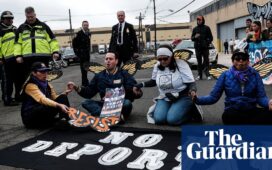Australia’s economy is increasingly in the doldrums, but our leaders can point to a successful export of their own devising. In the US, the Trump administration is bedding down and expanding its network of punitive refugee camps. Like Australia’s, they have a dual function: as a deterrent to pursuing the right of political asylum, and as a political weapon.
Australia’s nightmare, like the USA’s, has been long in the making. It is a bipartisan creation. Labor, under Paul Keating, instituted the policy of mandatory detention. John Howard did much of the work of shaping it into permanent nightmare, and of turning the issue of refugees into a cudgel with which to smite political opponents.
Howard created temporary protection visas in the late 1990s, leaving even successful applicants in a state of uncertainty. He fought and won an election on the issue of asylum seekers in 2001, establishing arbitrary cruelty as a political tactic to be used again by him and his successors. In the first years of the century, he excised large swathes of Australian territory from its migration zones, legislated the right to remove migrant vessels from Australian waters, and moved away from contested facilities like Woomera to the so-called “Pacific Solution”. Asylum seekers were increasingly out of reach for Australia’s media and those who opposed the policies.
Later embellishments under the Abbott and Morrison governments brought down total secrecy on interceptions, the practice of turning back boats at sea, and removed any hope that migrants arriving by sea might one day be granted permission to live in Australia.
Labor, after years of vacillating and ineffectual opposition to Howard’s policies, has long since capitulated on all of the important points. Despite fights around the edges on issues like Medevac, Labor’s surrender to the main thrust of asylum policy during the Rudd-Gillard era still holds.
It’s long been observed that any network of camps, once established, becomes worse. As Andrea Pitzer shows in her history of concentration camps, One Long Night, over and over again since the invention of concentration camps in the late 19th century, in each iteration they develop their own terrible, internal logic. Laws are circumvented or changed, secrecy inhibits scrutiny, logistical problems complicate detention such that the brunt is always borne by prisoners, and a dynamic of brutalization sweeps up prisoner, jailer, and the whole society surrounding them.
Even if such camps are not deliberately constructed for the purposes of murder, they kill people. In Australia’s camps, dozens have died, a score or more at their own hands. One of those, Omid Masoumali, set himself alight on Nauru during a UN inspection of the facility. Untold numbers of current and former detainees struggle with mental illness as a result of their detention.
Australia’s camps are now baked into its national politics. They look set to remain as long as there are elections to win, focus groups to placate, and no outside agency truly capable of enforcing any consequences for its architects. The longer that they are in place in the US, Italy, and elsewhere, the more likely it is that in those countries, too, they will become permanent features of the political landscape, and a test
As white settler cultures, Australia and the United States share many things. And one is a long history of confining and concentrating people that the settler population determines to be undesirable. In both countries, genocidal hot wars against native populations petered out into a practice dumping remnant indigenous people into reservations or missions.
The US starting using concentration camps in the modern sense in the Philippines at the very beginning of the 20th century. Both Australia and the United States interned Japanese and German residents as enemy aliens in the second world war; Australia also interned up to 20% of its resident Italians. The United States continues to operate its detention camp at Guantanamo Bay.
Neither country is a stranger to indefinitely imprisoning innocent or untried people. Australia’s innovation — one taken up in Europe as well as the United States — was in beginning in earnest to dismantle an always-fragile global consensus on the proper treatment of refugees.
The countries that had defeated fascism implicitly recognised that their own failure to do more to help refugees had delivered hostages to the Nazi regime, and had passively contributed to the nightmare of the Holocaust and its network of camps. It was not always perfectly honored, and in the case of the US, a great deal of emphasis was put on accommodating refugees from Communist nations, with a view to scoring propaganda victories. but for the half century following the signing of the UN Charter on Refugees in 1951, liberal democracies paid some level of respect to the notion of political asylum as a human right.
Australia turned that on its head when it started down the road of arbitrarily punishing those fleeing war, violence, and persecution. When conservatives then aggressively politicized that fact, they created a model.
Back in 2014, scholar Angela Mitropoulos wrote in the wake of the initiation of Operation Sovereign Borders that “this downward spiral is not just Australia’s problem. Australia has long been a laboratory for the invention and export of policies around the world.” She argued that the opposition to camps cannot succeed on the basis of national politics, that opposition must globalized.
The deterioration of the overfilled camps on America’s southern border, and the moves to house people on military bases and former internment camps, t show that she was right.
The worsening conditions those camps have been associated with include deaths, family separations, and serious mistreatment of asylum seekers. Trump has tightened restrictions on how, who, and how many people can apply for asylum. The administration has dramatically raised the bar for asylum applications with fees, additional rules, and long delays as people wait in camps. He has threatened blanket measures to deny asylum altogether to Central Americans waiting in Mexico.
And they have sought to turn Americans — or at least the Republican base — more firmly against immigrants and asylum seekers. He and his administration have stepped up dehumanising language about asylum seekers and migrants. He has taken every opportunity to make political hay from scare stories about asylum seekers. All the while, conservatives have sought to avoid calling these camps by their most appropriate name.
The Australian experience suggests that once established, such camps are difficult to dislodge within the routines of national politics. To disestablish these camps anywhere, we need to oppose them everywhere.








